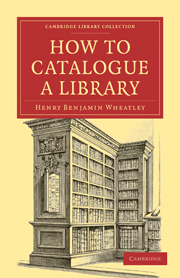Book contents
- Frontmatter
- PREFACE
- Contents
- CHAP. I INTRODUCTION
- CHAP. II BATTLE OF THE RULES
- CHAP. III PRINT versus MANUSCRIPT
- CHAP. IV How TO TREAT A TITLE-PAGE
- CHAP. V REFERENCES AND SUBJECT INDEX
- CHAP. VI ARRANGEMENT
- CHAP. VII SOMETHING ABOUT MSS
- CHAP. VIII RULES FOR A SMALL LIBRARY
- APPENDIX: LIST OF LATIN NAMES OF PLACES
- INDEX
CHAP. VI - ARRANGEMENT
Published online by Cambridge University Press: 05 March 2012
- Frontmatter
- PREFACE
- Contents
- CHAP. I INTRODUCTION
- CHAP. II BATTLE OF THE RULES
- CHAP. III PRINT versus MANUSCRIPT
- CHAP. IV How TO TREAT A TITLE-PAGE
- CHAP. V REFERENCES AND SUBJECT INDEX
- CHAP. VI ARRANGEMENT
- CHAP. VII SOMETHING ABOUT MSS
- CHAP. VIII RULES FOR A SMALL LIBRARY
- APPENDIX: LIST OF LATIN NAMES OF PLACES
- INDEX
Summary
Rule II. of the British Museum is: “Titles to be arranged alphabetically, according to the English alphabet only (whatever be the order of the alphabet in which a foreign name might have been entered in its original language);” and this rule has been generally followed. Mr. Cutter (rule 169) adds to this, “Treat I and J, U and V, as separate letters;” and every consulter of the British Museum Catalogue must wish that this rule was adopted there, for anything so confusing as this unnecessary mixing of the letters I and J and U and V it is scarcely possible to imagine. Mr. Cutter goes on: “ij, at least in the olden Dutch names, should be arranged as y; do not put Spanish names beginning with Ch, LI, Ñ, after all other names beginning with C, L, and N, as is done by the Spanish Academy.”
The Museum rule (XIII.) is: “German names in which the letters ä, ö, or ü occur, to be spelt with the diphthong æ, œ, and ue respectively.”
Mr. Cutter follows this, and adds to it (rule 25):—
“In Danish names, if the type å is not to be had, use its older equivalent aa; in a manuscript catalogue the modern orthography ä should be employed. Whatever is chosen should be uniformly used, however the names may appear in the books. The diphthong æ should not be written ae, nor should ö be written oe; ö, not œ, should be used for ϕ.
- Type
- Chapter
- Information
- How to Catalogue a Library , pp. 198 - 227Publisher: Cambridge University PressPrint publication year: 2010First published in: 1889



